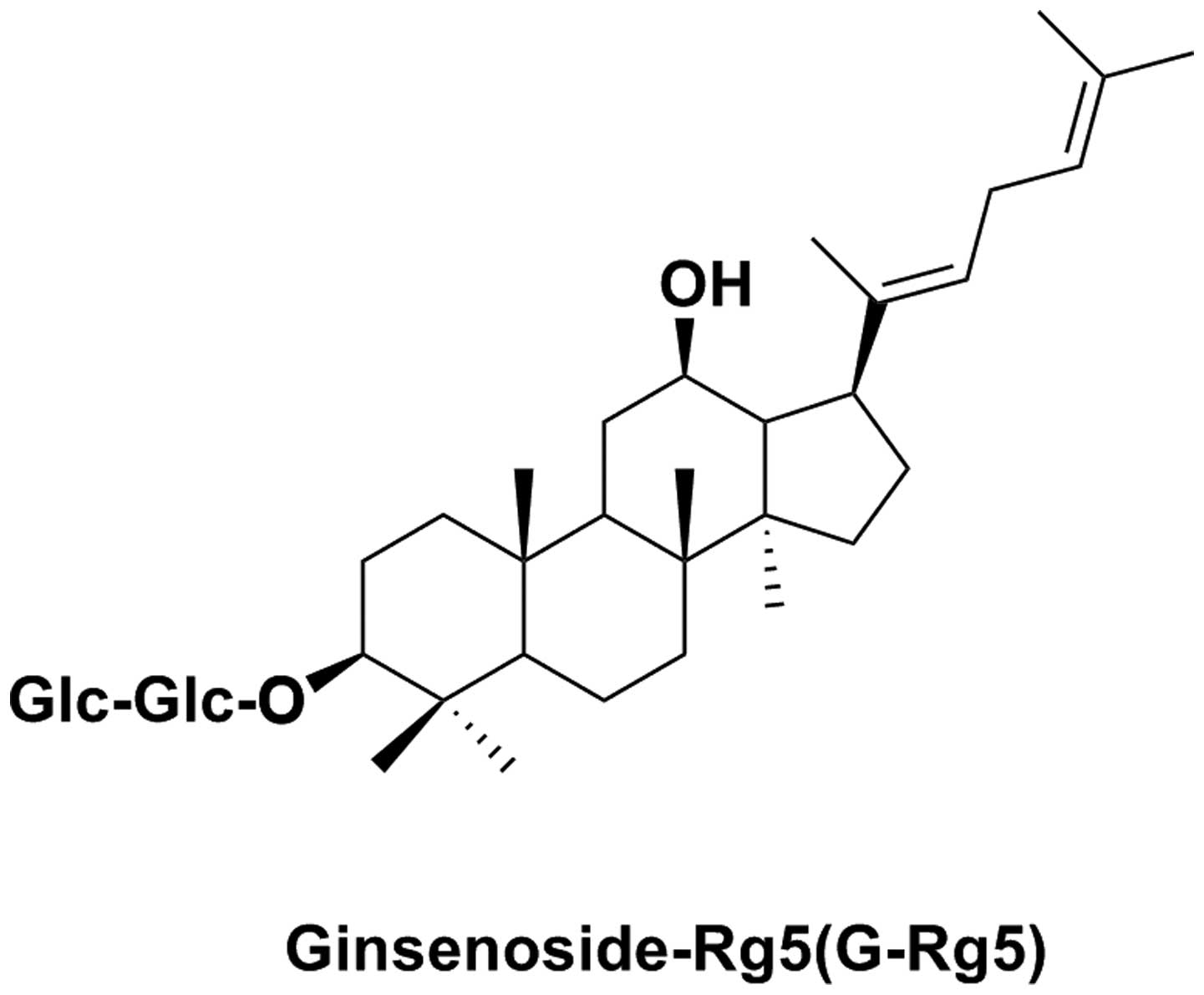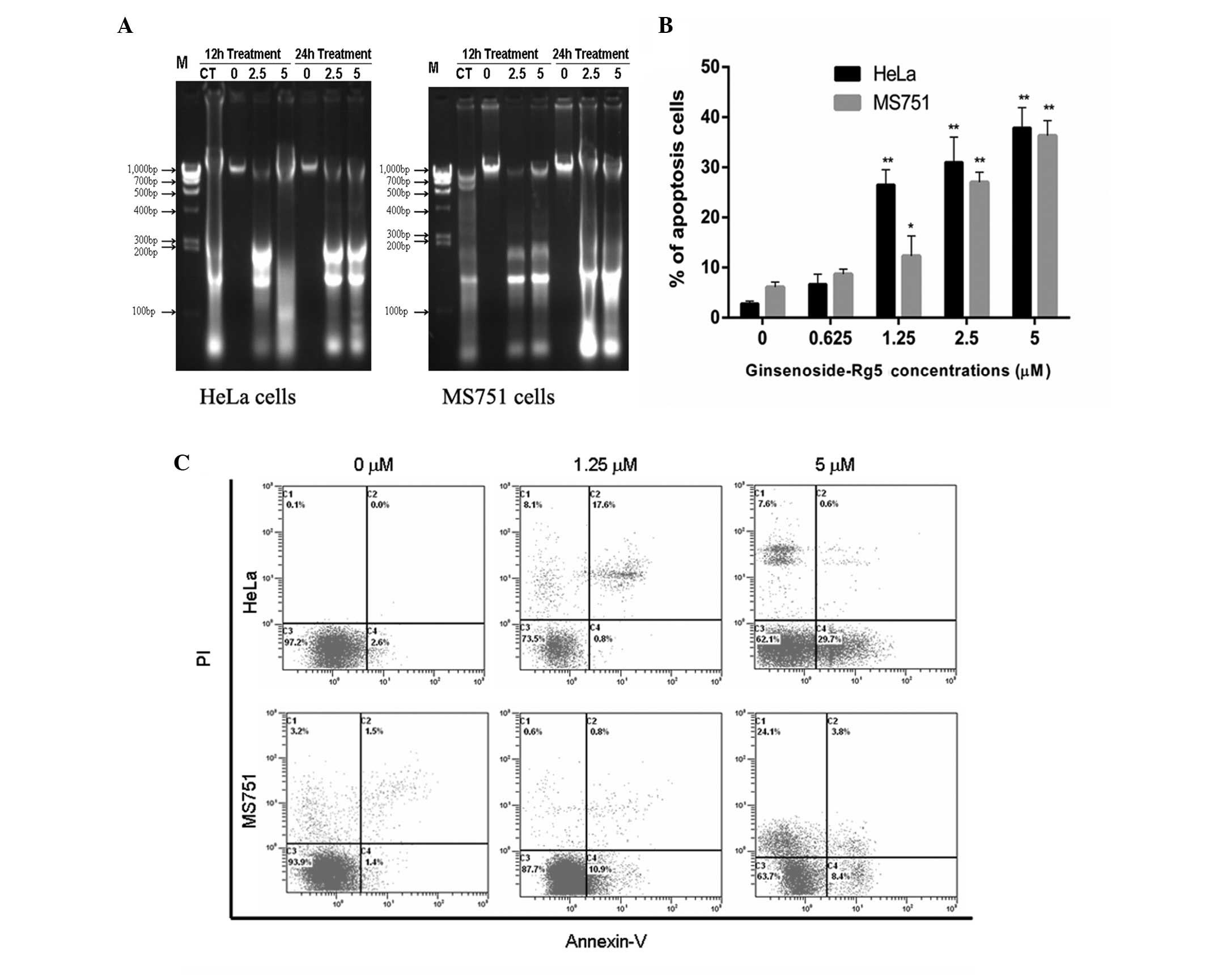|
1
|
Saslow D, Castle PE, Cox JT, et al:
American Cancer Society. Guideline for human papillomavirus (HPV)
vaccine use to prevent cervical cancer and its precursors. CA
Cancer J Clin. 57:7–28. 2007. View Article : Google Scholar : PubMed/NCBI
|
|
2
|
Steben M and Duarte-Franco E: Human
papillomavirus infection: epidemiology and pathophysiology. Gynecol
Oncol. 107:S2–S5. 2007. View Article : Google Scholar : PubMed/NCBI
|
|
3
|
Long HJ 3rd: Management of metastatic
cervical cancer: review of the literature. J Clin Oncol.
25:2966–2974. 2007. View Article : Google Scholar : PubMed/NCBI
|
|
4
|
Brinkman JA, Caffrey AS, Muderspach LI,
Roman LD and Kast WM: Inhibitory effect of ginsenoside Rg5 and its
metabolite ginsenoside Rh3 in an oxazolone induced mouse chronic
dermatitis model. Eur J Gynaecol Oncol. 26:129–142. 2005.
|
|
5
|
Leitao MM Jr and Chi DS: Recurrent
cervical cancer. Curr Treat Options Oncol. 3:105–111. 2002.
View Article : Google Scholar : PubMed/NCBI
|
|
6
|
Yang J, Li J, Sun M and Chen K: Studies of
traditional Chinese medicine monomer on HeLa cell of cervical
cancer. Pak J Pharm Sci. 27(4 Suppl): 1063–1068. 2014.PubMed/NCBI
|
|
7
|
Cohen I, Tagliaferri M and Tripathy D:
Traditional Chinese medicine in the treatment of breast cancer.
Semin Oncol. 29:563–574. 2002. View Article : Google Scholar
|
|
8
|
Li X, Yang G, Li X, et al: Traditional
Chinese medicine in cancer care: a review of controlled clinical
studies published in Chinese. PloS One. 8:e603382013. View Article : Google Scholar : PubMed/NCBI
|
|
9
|
Yang G, Li X, Li X, et al: Traditional
chinese medicine in cancer care: a review of case series published
in the chinese literature. Evid Based Complement Alternat Med.
2012.7510–7546. 2012.
|
|
10
|
Liu J, Li X, Liu J, Ma L, Li X and Fønnebø
V: Traditional Chinese medicine in cancer care: a review of case
reports published in Chinese literature. Forsch Komplementarmed.
18:257–263. 2011. View Article : Google Scholar
|
|
11
|
Kwon SW, Han SB, Park IH, Kim JM, Park MK
and Park JH: Liquid chromatographic determination of less polar
ginsenosides in processed ginseng. J Chromatogr A. 921:335–339.
2001. View Article : Google Scholar : PubMed/NCBI
|
|
12
|
Kim SN, Ha YW, Shin H, Son SH, Wu SJ and
Kim YS: Simultaneous quantification of 14 ginsenosides in Panax
ginseng C.A. Meyer (Korean red ginseng) by HPLC-ELSD and its
application to quality control. J Pharm Biomed Anal. 45:164–170.
2007. View Article : Google Scholar : PubMed/NCBI
|
|
13
|
Yun TK, Lee YS, Lee YH, Kim SI and Yun HY:
Anticarcino genic effect of Panax ginseng C.A. Meyer and
identification of active compounds. J Korean Med Sci. 16:S6–S18.
2001. View Article : Google Scholar
|
|
14
|
Kang KS, Kim HY, Baek SH, et al: Study on
the hydroxyl radical scavenging activity changes of ginseng and
ginsenoside-Rb2 by heat processing. Biol Pharm Bull. 30:724–728.
2007. View Article : Google Scholar : PubMed/NCBI
|
|
15
|
Nag SA, Qin JJ, Wang W, et al:
Ginsenosides as anticancer agents: In vitro and in vivo activities,
structure-activity relationships, and molecular mechanisms of
action. Front Pharmacol. 3:252012. View Article : Google Scholar : PubMed/NCBI
|
|
16
|
Lee KY, Lee YH, Kim SI, Park JH and Lee
SK: Ginsenoside-Rg5 suppresses cyclin E-dependent protein kinase
activity via up-regulating p21Cip/WAF1 and down-regulating cyclin E
in SK-HEP-1 cells. Anticancer Res. 17:1067–1072. 1997.PubMed/NCBI
|
|
17
|
Shin YW, Bae EA and Kim DH: Inhibitory
effect of ginsenoside Rg5 and its metabolite ginsenoside Rh3 in an
oxazolone-induced mouse chronic dermatitis model. Arch Pharm Res.
29:685–690. 2006. View Article : Google Scholar : PubMed/NCBI
|
|
18
|
Kim TW, Joh EH, Kim B and Kim DH:
Ginsenoside Rg5 ameliorates lung inflammation in mice by inhibiting
the binding of LPS to toll-like receptor-4 on macrophages. Int
Immunopharmacol. 12:110–116. 2012. View Article : Google Scholar
|
|
19
|
Kim EJ, Jung IH, Van Le TK, Jeong JJ, Kim
NJ and Kim DH: Ginsenosides Rg5 and Rh3 protect scopolamine-induced
memory deficits in mice. J Ethnopharmacol. 146:294–299. 2013.
View Article : Google Scholar : PubMed/NCBI
|
|
20
|
Lee YY, Park JS, Jung JS, Kim DH and Kim
HS: Anti-inflammatory effect of ginsenoside Rg5 in
lipopolysaccharide-stimulated BV2 microglial cells. Int J Mol Sci.
14:9820–9833. 2013. View Article : Google Scholar : PubMed/NCBI
|
|
21
|
Kawai K, Liu SX, Tyurin VA, et al:
Antioxidant and antiapoptotic function of metallothioneins in HL-60
cells challenged with copper nitrilotriacetate. Chem Res Toxicol.
13:1275–1286. 2000. View Article : Google Scholar : PubMed/NCBI
|
|
22
|
Wu SB, Su JJ, Sun LH, et al: Triterpenoids
and steroids from the fruits of Melia toosendan and their cytotoxic
effects on two human cancer cell lines. J Natl Prod. 73:1898–1906.
2010. View Article : Google Scholar
|
|
23
|
Nakadai A, Li Q and Kawada T: Chlorpyrifos
induces apoptosis in human monocyte cell line U937. Toxicology.
224:202–209. 2006. View Article : Google Scholar : PubMed/NCBI
|
|
24
|
Guanggang X, Diqiu L, Jianzhong Y, et al:
Carbamate insecticide methomyl confers cytotoxicity through DNA
damage induction. Food Chem Toxicol. 53:352–358. 2013. View Article : Google Scholar
|
|
25
|
Zhang YH, Li HD, Li B, Jiang SD and Jiang
LS: Ginsenoside Rg3 induces DNA damage in human osteosarcoma cells
and reduces MNNG-induced DNA damage and apoptosis in normal human
cells. Oncol Rep. 31:919–925. 2014.
|
|
26
|
Wu GS, Lu JJ, Guo JJ, et al: Ganoderic
acid DM, a natural triterpenoid, induces DNA damage, G1 cell cycle
arrest and apoptosis in human breast cancer cells. Fitoterapia.
83:408–414. 2012. View Article : Google Scholar
|
|
27
|
Sokolov MV, Smilenov LB, Hall EJ, Panyutin
IG, Bonner WM and Sedelnikova OA: Ionizing radiation induces DNA
double-strand breaks in bystander primary human fibroblasts.
Oncogene. 24:7257–7265. 2005. View Article : Google Scholar : PubMed/NCBI
|
|
28
|
Parry MC, Bhabra G, Sood A, et al:
Thresholds for indirect DNA damage across cellular barriers for
orthopaedic biomaterials. Biomaterials. 31:4477–4483. 2010.
View Article : Google Scholar : PubMed/NCBI
|
|
29
|
Toh DF, Patel DN, Chan EC, Teo A, Neo SY
and Koh HL: Anti-proliferative effects of raw and steamed extracts
of Panax notoginseng and its ginsenoside constituents on human
liver cancer cells. Chin Med. 6:42011. View Article : Google Scholar : PubMed/NCBI
|
|
30
|
Yue PY, Mak NK, Cheng YK, et al:
Pharmacogenomics and the Yin/Yang actions of ginseng: anti-tumor,
angiomodulating and steroid-like activities of ginsenosides. Chin
Med. 2:62007. View Article : Google Scholar : PubMed/NCBI
|
|
31
|
Bras M, Queenan B and Susin SA: Programmed
cell death via mitochondria: different modes of dying. Biochemistry
(Mosc). 70:231–239. 2005. View Article : Google Scholar
|
|
32
|
Broker LE, Kruyt FA and Giaccone G: Cell
death independent of caspases: a review. Clin Cancer Res.
11:3155–3162. 2005. View Article : Google Scholar : PubMed/NCBI
|
|
33
|
Edinger AL and Thompson CB: Death by
design: apoptosis, necrosis and autophagy. Curr Opin Cell Biol.
16:663–669. 2004. View Article : Google Scholar : PubMed/NCBI
|
|
34
|
Kim HS, Lee EH, Ko SR, Choi KJ, Park JH
and Im DS: Effects of ginsenosides Rg3 and Rh2 on the proliferation
of prostate cancer cells. Arch Pharm Res. 27:429–435. 2004.
View Article : Google Scholar : PubMed/NCBI
|
|
35
|
Park HM, Kim SJ, Kim JS and Kang HS:
Reactive oxygen species mediated ginsenoside Rg3- and Rh2-induced
apoptosis in hepatoma cells through mitochondrial signaling
pathways. Food Chem Toxicol. 50:2736–2741. 2012. View Article : Google Scholar : PubMed/NCBI
|
|
36
|
Li B, Zhao J, Wang CZ, et al: Ginsenoside
Rh2 induces apoptosis and paraptosis-like cell death in colorectal
cancer cells through activation of p53. Cancer Lett. 301:185–192.
2011. View Article : Google Scholar : PubMed/NCBI
|
|
37
|
Kim SE, Lee YH, Park JH and Lee SK:
Ginsenoside-Rs4, a new type of ginseng saponin concurrently induces
apoptosis and selectively elevates protein levels of p53 and
p21WAF1 in human hepatoma SK-HEP-1 cells. Eur J Cancer. 35:507–511.
1999. View Article : Google Scholar : PubMed/NCBI
|
|
38
|
Oh SH and Lee BH: A ginseng saponin
metabolite-induced apoptosis in HepG2 cells involves a
mitochondria-mediated pathway and its downstream caspase-8
activation and Bid cleavage. Toxicol Appl Pharmacol. 194:221–229.
2004. View Article : Google Scholar : PubMed/NCBI
|
|
39
|
Robertson JD and Orrenius S: Role of
mitochondria in toxic cell death. Toxicology. 181–182:491–496.
2002. View Article : Google Scholar
|
|
40
|
Poon PY, Kwok HH, Yue PY, et al:
Cytoprotective effect of 20S-Rg3 on benzo[a]pyrene-induced DNA
damage. Drug Metab Dispos. 40:120–129. 2012. View Article : Google Scholar
|
|
41
|
Cotelle S and Férard JF: Comet assay in
genetic ecotoxicology: a review. Environ Mol Mutagen. 34:246–255.
1999. View Article : Google Scholar
|
|
42
|
Yu Y, Zhu W, Diao H, Zhou C, Chen FF and
Yang J: A comparative study of using comet assay and gammaH2AX foci
formation in the detection of
N-methyl-N′-nitro-N-nitrosoguanidine-induced DNA damage. Toxicology
In Vitro. 20:959–965. 2006. View Article : Google Scholar
|















